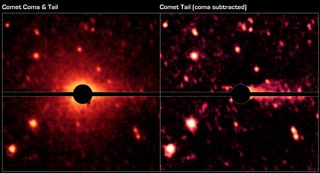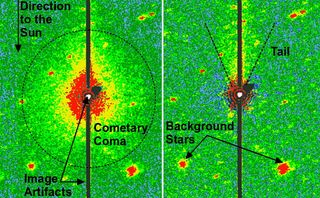Surprise! Near-Earth Asteroid Is Actually 'Sopping Wet' Comet

A recent discovery reads like a Monty Python comedy sketch: bringing out a dead comet that was actually not dead.
Scientists spotted a faint atmosphere called a coma around 3552 Don Quixote, an object classified as a near-Earth asteroid. The space rock was thought by some to be a "dead comet" — one that had shed its carbon dioxide and possible water ices long ago, after the ices were evaporated by the sun.
The orbit of Don Quixote resembled that of a comet, an object that originates in the Oort Cloud collection of icy objects far beyond Neptune's orbit. Scientists, however, did not spot any ice bleeding from Don Quixote when it got close to the sun, so they suspected it was a dead comet. That is, until recently, when such a tail was spotted in observations by NASA's Spitzer Space Telescope. [Amazing Comet Photos of 2013 by Stargazers]
"This discovery of carbon dioxide emission from Don Quixote required the sensitivity and infrared wavelengths of the Spitzer telescope and would not have been possible using telescopes on the ground," Michael Mommert, a post-doctoral researcher at Northern Arizona University (NAU), said in a statement. He conducted the research at a previous post at the German Aerospace Center.
Comets, sometimes called "dirty snowballs," are composed of rock and various types of ices. Some researchers think comets might have brought organic molecules and water to Earth, facilitating life.
As a comet approaches the sun, the heat causes some ice to vaporize, forming a coma or tenuous atmosphere around the comet, while the dust streams away in a tail that sometimes can be spotted from Earth. Repeat visitors to the sun's neighborhood lose more and more of their ices until the supply is exhausted.
Don Quixote wanders in an orbit that skirts the Earth, in a trajectory that is extremely unlikely to impact the planet, as it commutes between Jupiter and the sun. When Mommert's team turned the Spitzer telescope on Don Quixote in August 2009, the asteroid appeared brighter than expected.
Sign up for the Live Science daily newsletter now
Get the world’s most fascinating discoveries delivered straight to your inbox.
"The images were not as clean as we would like, so we set them aside," said NAU associate professor David Trilling in a statement.

The researchers decided to take a second look some time later, and compared infrared images with help from the Harvard-Smithsonian Center for Astrophysics. That's when the coma popped out.
It turns out the "sopping wet" Don Quixote still contains about 100 billion tons of water ice, roughly the same amount that is found in Lake Tahoe in the Sierra Nevada mountain range, Trilling said.
The discovery suggests that other comets could be masking as asteroids, which are rocky worlds that orbit the sun but are too small to be considered planets, the researchers added.
Mommert presented the findings Sept. 10 at the European Planetary Science Conference in London.
This story was provided by SPACE.com, a sister site to LiveScience. Follow Elizabeth Howell @howellspace, or SPACE.com @Spacedotcom. We're also on Facebook and Google+. Original article on SPACE.com.


